Analyzing Change Management Strategies at McDonald's Australia
VerifiedAdded on 2023/06/05
|10
|2791
|252
Essay
AI Summary
This critical essay examines the change management strategies of McDonald's within the Australian fast-food market. The essay begins by highlighting the importance of adapting to external factors like market environment and customer preferences, particularly in a foreign market. It then provides background information on McDonald's, its market segmentation, and core strategies. The main body of the essay explores environmental shifts, social factors, and technological changes influencing McDonald's operations in Australia. It delves into the company's responses to increasing health consciousness, competition, and changing customer expectations. The essay also discusses change management theories, including the incremental and continuous transformation models, and the ADKAR model. The application of these models is explained in the context of McDonald's technological advancements and its efforts to enhance customer experience. The conclusion summarizes the importance of change management for McDonald's to sustain its market position and meet the evolving demands of its consumers.
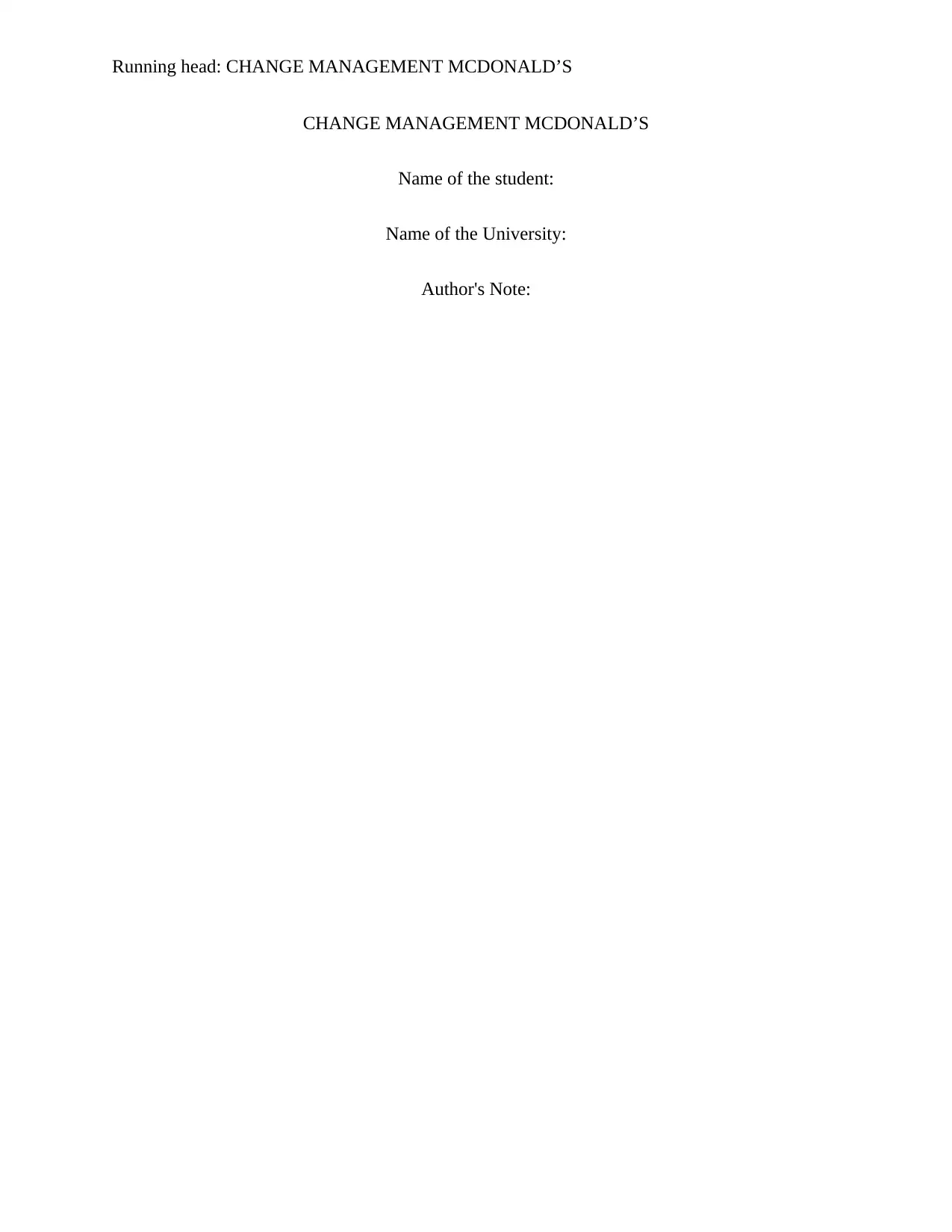
Running head: CHANGE MANAGEMENT MCDONALD’S
CHANGE MANAGEMENT MCDONALD’S
Name of the student:
Name of the University:
Author's Note:
CHANGE MANAGEMENT MCDONALD’S
Name of the student:
Name of the University:
Author's Note:
Paraphrase This Document
Need a fresh take? Get an instant paraphrase of this document with our AI Paraphraser
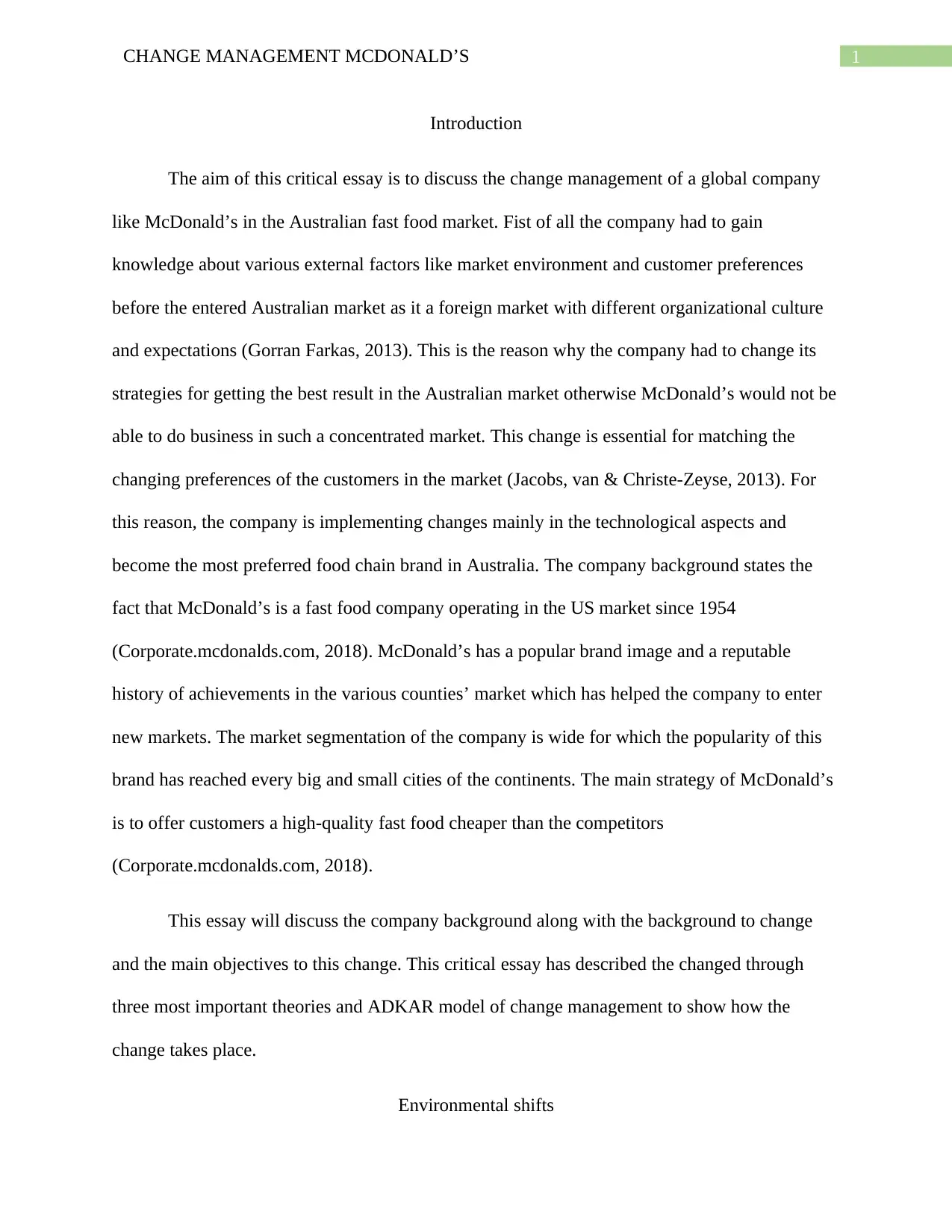
1CHANGE MANAGEMENT MCDONALD’S
Introduction
The aim of this critical essay is to discuss the change management of a global company
like McDonald’s in the Australian fast food market. Fist of all the company had to gain
knowledge about various external factors like market environment and customer preferences
before the entered Australian market as it a foreign market with different organizational culture
and expectations (Gorran Farkas, 2013). This is the reason why the company had to change its
strategies for getting the best result in the Australian market otherwise McDonald’s would not be
able to do business in such a concentrated market. This change is essential for matching the
changing preferences of the customers in the market (Jacobs, van & Christe-Zeyse, 2013). For
this reason, the company is implementing changes mainly in the technological aspects and
become the most preferred food chain brand in Australia. The company background states the
fact that McDonald’s is a fast food company operating in the US market since 1954
(Corporate.mcdonalds.com, 2018). McDonald’s has a popular brand image and a reputable
history of achievements in the various counties’ market which has helped the company to enter
new markets. The market segmentation of the company is wide for which the popularity of this
brand has reached every big and small cities of the continents. The main strategy of McDonald’s
is to offer customers a high-quality fast food cheaper than the competitors
(Corporate.mcdonalds.com, 2018).
This essay will discuss the company background along with the background to change
and the main objectives to this change. This critical essay has described the changed through
three most important theories and ADKAR model of change management to show how the
change takes place.
Environmental shifts
Introduction
The aim of this critical essay is to discuss the change management of a global company
like McDonald’s in the Australian fast food market. Fist of all the company had to gain
knowledge about various external factors like market environment and customer preferences
before the entered Australian market as it a foreign market with different organizational culture
and expectations (Gorran Farkas, 2013). This is the reason why the company had to change its
strategies for getting the best result in the Australian market otherwise McDonald’s would not be
able to do business in such a concentrated market. This change is essential for matching the
changing preferences of the customers in the market (Jacobs, van & Christe-Zeyse, 2013). For
this reason, the company is implementing changes mainly in the technological aspects and
become the most preferred food chain brand in Australia. The company background states the
fact that McDonald’s is a fast food company operating in the US market since 1954
(Corporate.mcdonalds.com, 2018). McDonald’s has a popular brand image and a reputable
history of achievements in the various counties’ market which has helped the company to enter
new markets. The market segmentation of the company is wide for which the popularity of this
brand has reached every big and small cities of the continents. The main strategy of McDonald’s
is to offer customers a high-quality fast food cheaper than the competitors
(Corporate.mcdonalds.com, 2018).
This essay will discuss the company background along with the background to change
and the main objectives to this change. This critical essay has described the changed through
three most important theories and ADKAR model of change management to show how the
change takes place.
Environmental shifts
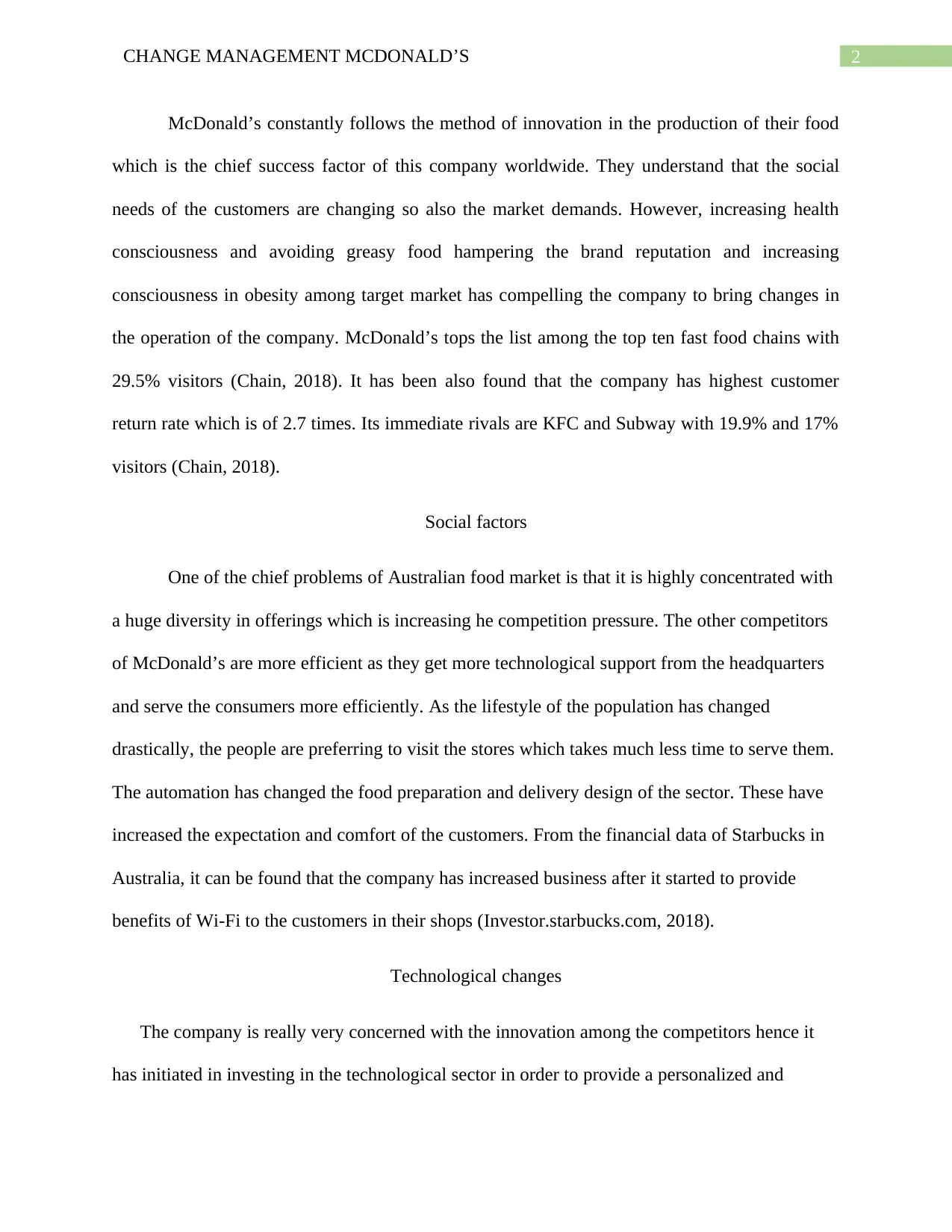
2CHANGE MANAGEMENT MCDONALD’S
McDonald’s constantly follows the method of innovation in the production of their food
which is the chief success factor of this company worldwide. They understand that the social
needs of the customers are changing so also the market demands. However, increasing health
consciousness and avoiding greasy food hampering the brand reputation and increasing
consciousness in obesity among target market has compelling the company to bring changes in
the operation of the company. McDonald’s tops the list among the top ten fast food chains with
29.5% visitors (Chain, 2018). It has been also found that the company has highest customer
return rate which is of 2.7 times. Its immediate rivals are KFC and Subway with 19.9% and 17%
visitors (Chain, 2018).
Social factors
One of the chief problems of Australian food market is that it is highly concentrated with
a huge diversity in offerings which is increasing he competition pressure. The other competitors
of McDonald’s are more efficient as they get more technological support from the headquarters
and serve the consumers more efficiently. As the lifestyle of the population has changed
drastically, the people are preferring to visit the stores which takes much less time to serve them.
The automation has changed the food preparation and delivery design of the sector. These have
increased the expectation and comfort of the customers. From the financial data of Starbucks in
Australia, it can be found that the company has increased business after it started to provide
benefits of Wi-Fi to the customers in their shops (Investor.starbucks.com, 2018).
Technological changes
The company is really very concerned with the innovation among the competitors hence it
has initiated in investing in the technological sector in order to provide a personalized and
McDonald’s constantly follows the method of innovation in the production of their food
which is the chief success factor of this company worldwide. They understand that the social
needs of the customers are changing so also the market demands. However, increasing health
consciousness and avoiding greasy food hampering the brand reputation and increasing
consciousness in obesity among target market has compelling the company to bring changes in
the operation of the company. McDonald’s tops the list among the top ten fast food chains with
29.5% visitors (Chain, 2018). It has been also found that the company has highest customer
return rate which is of 2.7 times. Its immediate rivals are KFC and Subway with 19.9% and 17%
visitors (Chain, 2018).
Social factors
One of the chief problems of Australian food market is that it is highly concentrated with
a huge diversity in offerings which is increasing he competition pressure. The other competitors
of McDonald’s are more efficient as they get more technological support from the headquarters
and serve the consumers more efficiently. As the lifestyle of the population has changed
drastically, the people are preferring to visit the stores which takes much less time to serve them.
The automation has changed the food preparation and delivery design of the sector. These have
increased the expectation and comfort of the customers. From the financial data of Starbucks in
Australia, it can be found that the company has increased business after it started to provide
benefits of Wi-Fi to the customers in their shops (Investor.starbucks.com, 2018).
Technological changes
The company is really very concerned with the innovation among the competitors hence it
has initiated in investing in the technological sector in order to provide a personalized and
⊘ This is a preview!⊘
Do you want full access?
Subscribe today to unlock all pages.

Trusted by 1+ million students worldwide
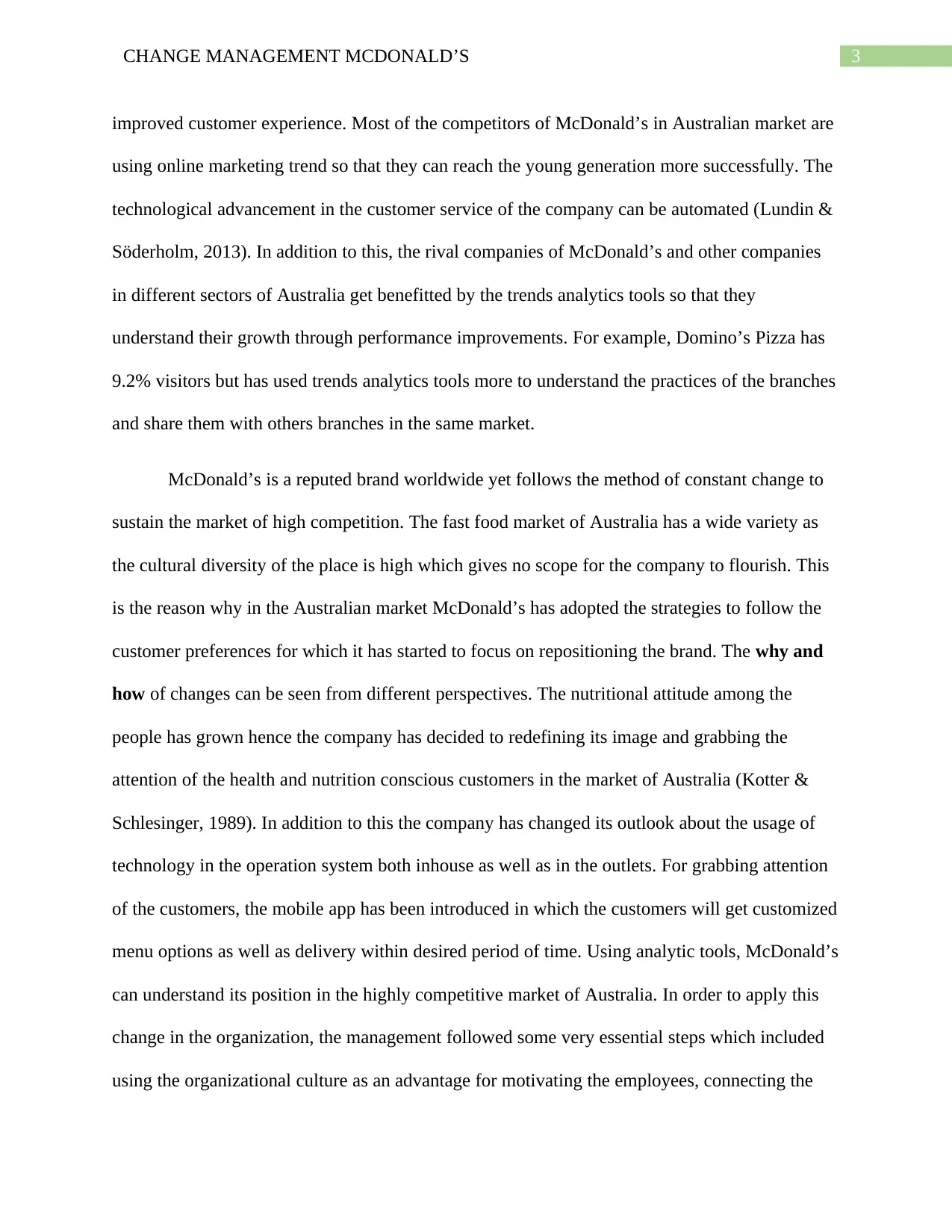
3CHANGE MANAGEMENT MCDONALD’S
improved customer experience. Most of the competitors of McDonald’s in Australian market are
using online marketing trend so that they can reach the young generation more successfully. The
technological advancement in the customer service of the company can be automated (Lundin &
Söderholm, 2013). In addition to this, the rival companies of McDonald’s and other companies
in different sectors of Australia get benefitted by the trends analytics tools so that they
understand their growth through performance improvements. For example, Domino’s Pizza has
9.2% visitors but has used trends analytics tools more to understand the practices of the branches
and share them with others branches in the same market.
McDonald’s is a reputed brand worldwide yet follows the method of constant change to
sustain the market of high competition. The fast food market of Australia has a wide variety as
the cultural diversity of the place is high which gives no scope for the company to flourish. This
is the reason why in the Australian market McDonald’s has adopted the strategies to follow the
customer preferences for which it has started to focus on repositioning the brand. The why and
how of changes can be seen from different perspectives. The nutritional attitude among the
people has grown hence the company has decided to redefining its image and grabbing the
attention of the health and nutrition conscious customers in the market of Australia (Kotter &
Schlesinger, 1989). In addition to this the company has changed its outlook about the usage of
technology in the operation system both inhouse as well as in the outlets. For grabbing attention
of the customers, the mobile app has been introduced in which the customers will get customized
menu options as well as delivery within desired period of time. Using analytic tools, McDonald’s
can understand its position in the highly competitive market of Australia. In order to apply this
change in the organization, the management followed some very essential steps which included
using the organizational culture as an advantage for motivating the employees, connecting the
improved customer experience. Most of the competitors of McDonald’s in Australian market are
using online marketing trend so that they can reach the young generation more successfully. The
technological advancement in the customer service of the company can be automated (Lundin &
Söderholm, 2013). In addition to this, the rival companies of McDonald’s and other companies
in different sectors of Australia get benefitted by the trends analytics tools so that they
understand their growth through performance improvements. For example, Domino’s Pizza has
9.2% visitors but has used trends analytics tools more to understand the practices of the branches
and share them with others branches in the same market.
McDonald’s is a reputed brand worldwide yet follows the method of constant change to
sustain the market of high competition. The fast food market of Australia has a wide variety as
the cultural diversity of the place is high which gives no scope for the company to flourish. This
is the reason why in the Australian market McDonald’s has adopted the strategies to follow the
customer preferences for which it has started to focus on repositioning the brand. The why and
how of changes can be seen from different perspectives. The nutritional attitude among the
people has grown hence the company has decided to redefining its image and grabbing the
attention of the health and nutrition conscious customers in the market of Australia (Kotter &
Schlesinger, 1989). In addition to this the company has changed its outlook about the usage of
technology in the operation system both inhouse as well as in the outlets. For grabbing attention
of the customers, the mobile app has been introduced in which the customers will get customized
menu options as well as delivery within desired period of time. Using analytic tools, McDonald’s
can understand its position in the highly competitive market of Australia. In order to apply this
change in the organization, the management followed some very essential steps which included
using the organizational culture as an advantage for motivating the employees, connecting the
Paraphrase This Document
Need a fresh take? Get an instant paraphrase of this document with our AI Paraphraser
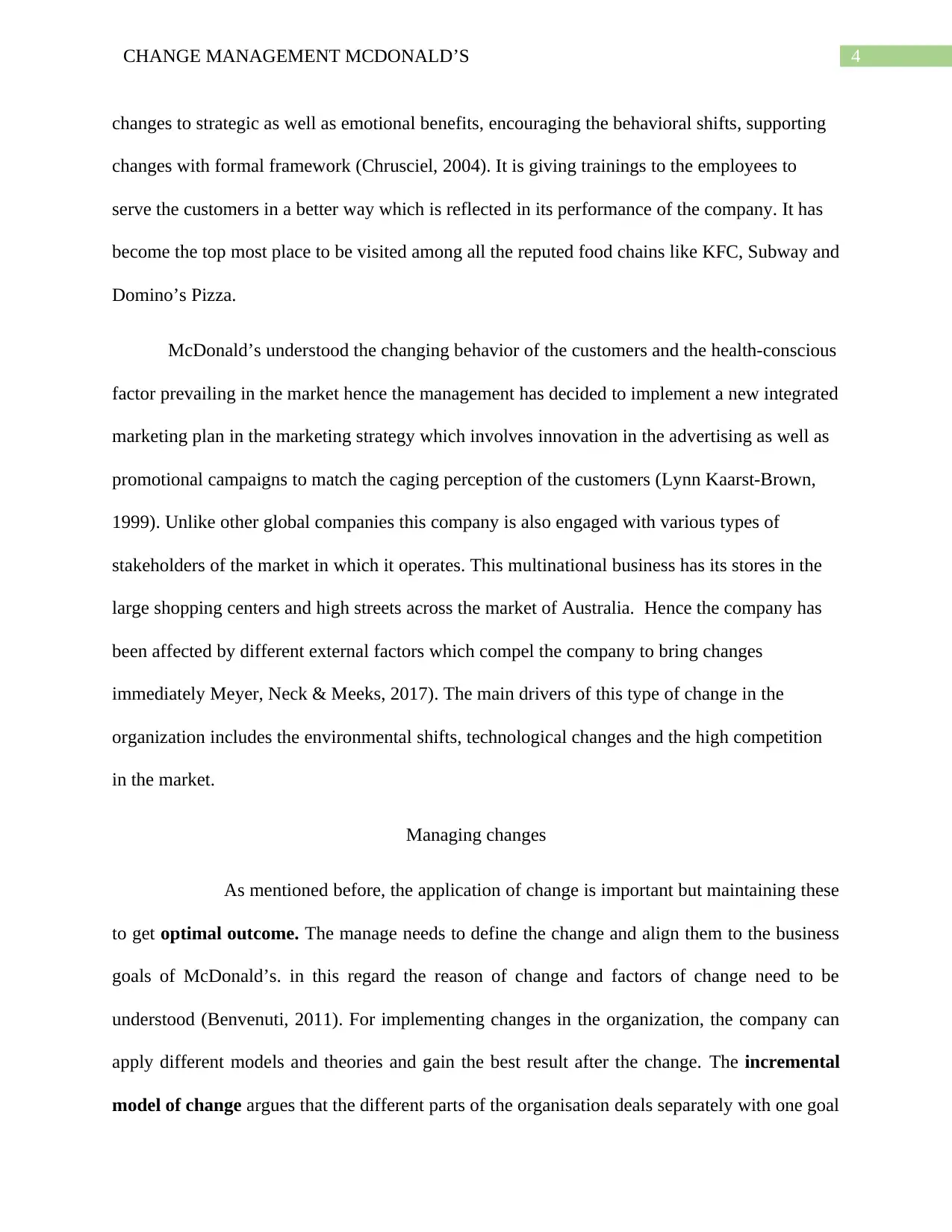
4CHANGE MANAGEMENT MCDONALD’S
changes to strategic as well as emotional benefits, encouraging the behavioral shifts, supporting
changes with formal framework (Chrusciel, 2004). It is giving trainings to the employees to
serve the customers in a better way which is reflected in its performance of the company. It has
become the top most place to be visited among all the reputed food chains like KFC, Subway and
Domino’s Pizza.
McDonald’s understood the changing behavior of the customers and the health-conscious
factor prevailing in the market hence the management has decided to implement a new integrated
marketing plan in the marketing strategy which involves innovation in the advertising as well as
promotional campaigns to match the caging perception of the customers (Lynn Kaarst-Brown,
1999). Unlike other global companies this company is also engaged with various types of
stakeholders of the market in which it operates. This multinational business has its stores in the
large shopping centers and high streets across the market of Australia. Hence the company has
been affected by different external factors which compel the company to bring changes
immediately Meyer, Neck & Meeks, 2017). The main drivers of this type of change in the
organization includes the environmental shifts, technological changes and the high competition
in the market.
Managing changes
As mentioned before, the application of change is important but maintaining these
to get optimal outcome. The manage needs to define the change and align them to the business
goals of McDonald’s. in this regard the reason of change and factors of change need to be
understood (Benvenuti, 2011). For implementing changes in the organization, the company can
apply different models and theories and gain the best result after the change. The incremental
model of change argues that the different parts of the organisation deals separately with one goal
changes to strategic as well as emotional benefits, encouraging the behavioral shifts, supporting
changes with formal framework (Chrusciel, 2004). It is giving trainings to the employees to
serve the customers in a better way which is reflected in its performance of the company. It has
become the top most place to be visited among all the reputed food chains like KFC, Subway and
Domino’s Pizza.
McDonald’s understood the changing behavior of the customers and the health-conscious
factor prevailing in the market hence the management has decided to implement a new integrated
marketing plan in the marketing strategy which involves innovation in the advertising as well as
promotional campaigns to match the caging perception of the customers (Lynn Kaarst-Brown,
1999). Unlike other global companies this company is also engaged with various types of
stakeholders of the market in which it operates. This multinational business has its stores in the
large shopping centers and high streets across the market of Australia. Hence the company has
been affected by different external factors which compel the company to bring changes
immediately Meyer, Neck & Meeks, 2017). The main drivers of this type of change in the
organization includes the environmental shifts, technological changes and the high competition
in the market.
Managing changes
As mentioned before, the application of change is important but maintaining these
to get optimal outcome. The manage needs to define the change and align them to the business
goals of McDonald’s. in this regard the reason of change and factors of change need to be
understood (Benvenuti, 2011). For implementing changes in the organization, the company can
apply different models and theories and gain the best result after the change. The incremental
model of change argues that the different parts of the organisation deals separately with one goal
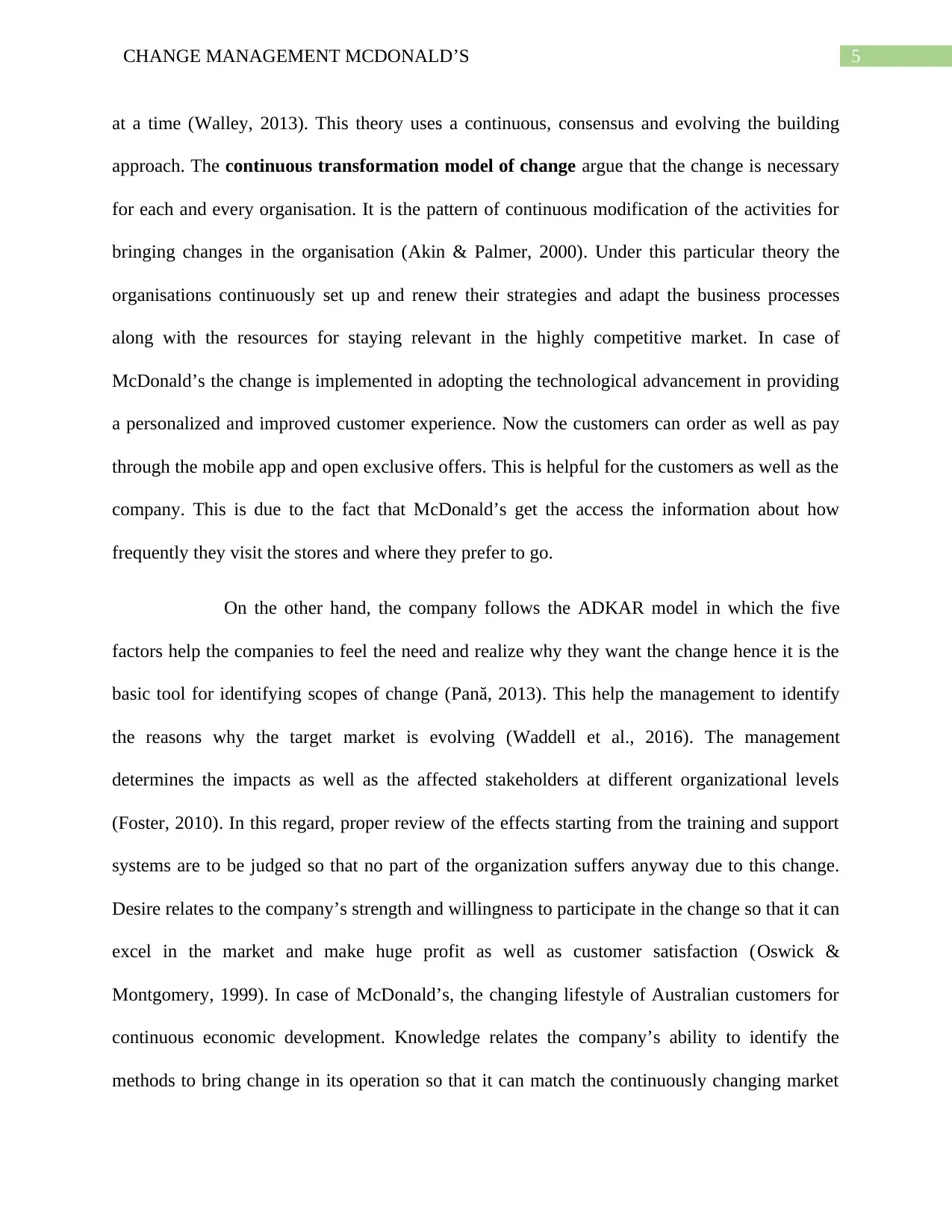
5CHANGE MANAGEMENT MCDONALD’S
at a time (Walley, 2013). This theory uses a continuous, consensus and evolving the building
approach. The continuous transformation model of change argue that the change is necessary
for each and every organisation. It is the pattern of continuous modification of the activities for
bringing changes in the organisation (Akin & Palmer, 2000). Under this particular theory the
organisations continuously set up and renew their strategies and adapt the business processes
along with the resources for staying relevant in the highly competitive market. In case of
McDonald’s the change is implemented in adopting the technological advancement in providing
a personalized and improved customer experience. Now the customers can order as well as pay
through the mobile app and open exclusive offers. This is helpful for the customers as well as the
company. This is due to the fact that McDonald’s get the access the information about how
frequently they visit the stores and where they prefer to go.
On the other hand, the company follows the ADKAR model in which the five
factors help the companies to feel the need and realize why they want the change hence it is the
basic tool for identifying scopes of change (Pană, 2013). This help the management to identify
the reasons why the target market is evolving (Waddell et al., 2016). The management
determines the impacts as well as the affected stakeholders at different organizational levels
(Foster, 2010). In this regard, proper review of the effects starting from the training and support
systems are to be judged so that no part of the organization suffers anyway due to this change.
Desire relates to the company’s strength and willingness to participate in the change so that it can
excel in the market and make huge profit as well as customer satisfaction (Oswick &
Montgomery, 1999). In case of McDonald’s, the changing lifestyle of Australian customers for
continuous economic development. Knowledge relates the company’s ability to identify the
methods to bring change in its operation so that it can match the continuously changing market
at a time (Walley, 2013). This theory uses a continuous, consensus and evolving the building
approach. The continuous transformation model of change argue that the change is necessary
for each and every organisation. It is the pattern of continuous modification of the activities for
bringing changes in the organisation (Akin & Palmer, 2000). Under this particular theory the
organisations continuously set up and renew their strategies and adapt the business processes
along with the resources for staying relevant in the highly competitive market. In case of
McDonald’s the change is implemented in adopting the technological advancement in providing
a personalized and improved customer experience. Now the customers can order as well as pay
through the mobile app and open exclusive offers. This is helpful for the customers as well as the
company. This is due to the fact that McDonald’s get the access the information about how
frequently they visit the stores and where they prefer to go.
On the other hand, the company follows the ADKAR model in which the five
factors help the companies to feel the need and realize why they want the change hence it is the
basic tool for identifying scopes of change (Pană, 2013). This help the management to identify
the reasons why the target market is evolving (Waddell et al., 2016). The management
determines the impacts as well as the affected stakeholders at different organizational levels
(Foster, 2010). In this regard, proper review of the effects starting from the training and support
systems are to be judged so that no part of the organization suffers anyway due to this change.
Desire relates to the company’s strength and willingness to participate in the change so that it can
excel in the market and make huge profit as well as customer satisfaction (Oswick &
Montgomery, 1999). In case of McDonald’s, the changing lifestyle of Australian customers for
continuous economic development. Knowledge relates the company’s ability to identify the
methods to bring change in its operation so that it can match the continuously changing market
⊘ This is a preview!⊘
Do you want full access?
Subscribe today to unlock all pages.

Trusted by 1+ million students worldwide
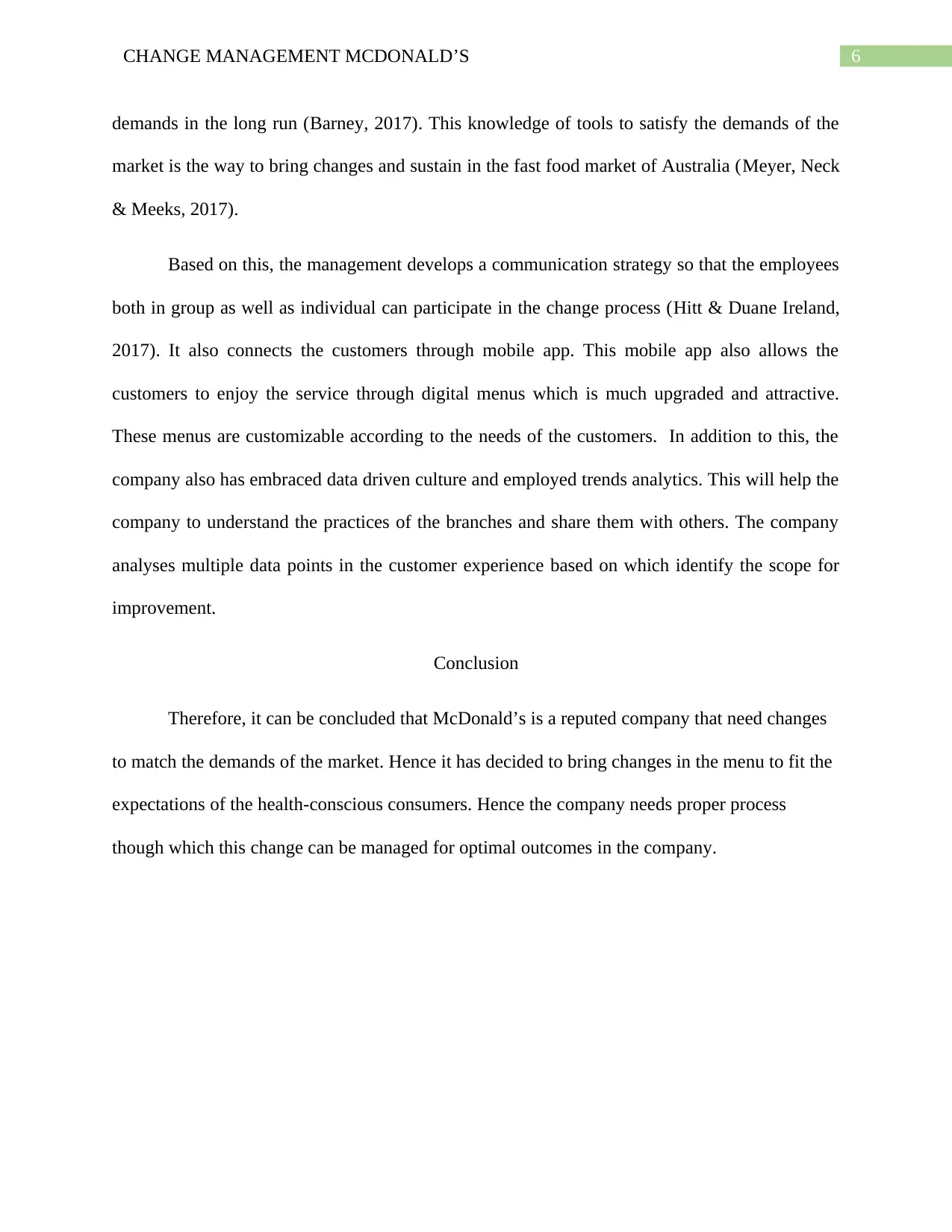
6CHANGE MANAGEMENT MCDONALD’S
demands in the long run (Barney, 2017). This knowledge of tools to satisfy the demands of the
market is the way to bring changes and sustain in the fast food market of Australia (Meyer, Neck
& Meeks, 2017).
Based on this, the management develops a communication strategy so that the employees
both in group as well as individual can participate in the change process (Hitt & Duane Ireland,
2017). It also connects the customers through mobile app. This mobile app also allows the
customers to enjoy the service through digital menus which is much upgraded and attractive.
These menus are customizable according to the needs of the customers. In addition to this, the
company also has embraced data driven culture and employed trends analytics. This will help the
company to understand the practices of the branches and share them with others. The company
analyses multiple data points in the customer experience based on which identify the scope for
improvement.
Conclusion
Therefore, it can be concluded that McDonald’s is a reputed company that need changes
to match the demands of the market. Hence it has decided to bring changes in the menu to fit the
expectations of the health-conscious consumers. Hence the company needs proper process
though which this change can be managed for optimal outcomes in the company.
demands in the long run (Barney, 2017). This knowledge of tools to satisfy the demands of the
market is the way to bring changes and sustain in the fast food market of Australia (Meyer, Neck
& Meeks, 2017).
Based on this, the management develops a communication strategy so that the employees
both in group as well as individual can participate in the change process (Hitt & Duane Ireland,
2017). It also connects the customers through mobile app. This mobile app also allows the
customers to enjoy the service through digital menus which is much upgraded and attractive.
These menus are customizable according to the needs of the customers. In addition to this, the
company also has embraced data driven culture and employed trends analytics. This will help the
company to understand the practices of the branches and share them with others. The company
analyses multiple data points in the customer experience based on which identify the scope for
improvement.
Conclusion
Therefore, it can be concluded that McDonald’s is a reputed company that need changes
to match the demands of the market. Hence it has decided to bring changes in the menu to fit the
expectations of the health-conscious consumers. Hence the company needs proper process
though which this change can be managed for optimal outcomes in the company.
Paraphrase This Document
Need a fresh take? Get an instant paraphrase of this document with our AI Paraphraser
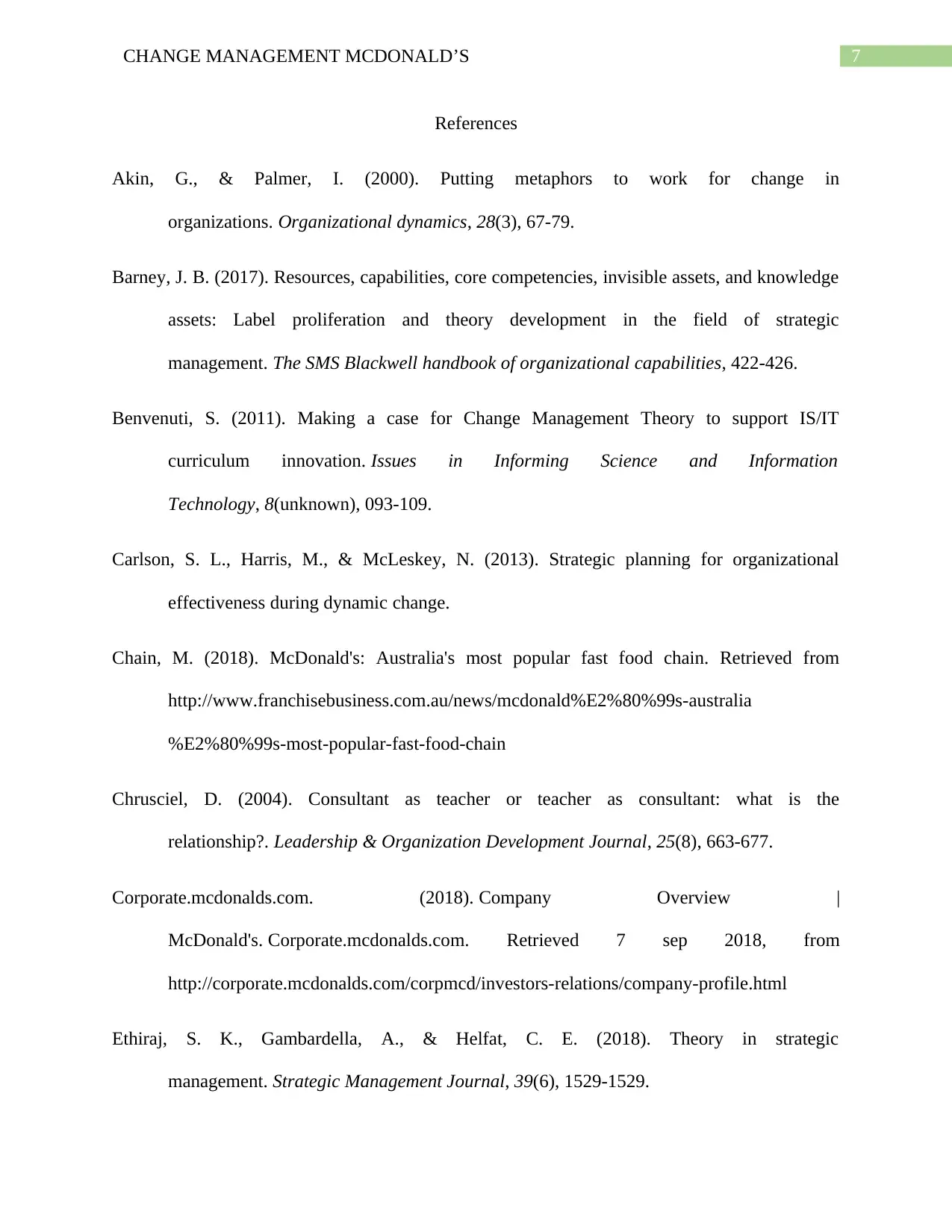
7CHANGE MANAGEMENT MCDONALD’S
References
Akin, G., & Palmer, I. (2000). Putting metaphors to work for change in
organizations. Organizational dynamics, 28(3), 67-79.
Barney, J. B. (2017). Resources, capabilities, core competencies, invisible assets, and knowledge
assets: Label proliferation and theory development in the field of strategic
management. The SMS Blackwell handbook of organizational capabilities, 422-426.
Benvenuti, S. (2011). Making a case for Change Management Theory to support IS/IT
curriculum innovation. Issues in Informing Science and Information
Technology, 8(unknown), 093-109.
Carlson, S. L., Harris, M., & McLeskey, N. (2013). Strategic planning for organizational
effectiveness during dynamic change.
Chain, M. (2018). McDonald's: Australia's most popular fast food chain. Retrieved from
http://www.franchisebusiness.com.au/news/mcdonald%E2%80%99s-australia
%E2%80%99s-most-popular-fast-food-chain
Chrusciel, D. (2004). Consultant as teacher or teacher as consultant: what is the
relationship?. Leadership & Organization Development Journal, 25(8), 663-677.
Corporate.mcdonalds.com. (2018). Company Overview |
McDonald's. Corporate.mcdonalds.com. Retrieved 7 sep 2018, from
http://corporate.mcdonalds.com/corpmcd/investors-relations/company-profile.html
Ethiraj, S. K., Gambardella, A., & Helfat, C. E. (2018). Theory in strategic
management. Strategic Management Journal, 39(6), 1529-1529.
References
Akin, G., & Palmer, I. (2000). Putting metaphors to work for change in
organizations. Organizational dynamics, 28(3), 67-79.
Barney, J. B. (2017). Resources, capabilities, core competencies, invisible assets, and knowledge
assets: Label proliferation and theory development in the field of strategic
management. The SMS Blackwell handbook of organizational capabilities, 422-426.
Benvenuti, S. (2011). Making a case for Change Management Theory to support IS/IT
curriculum innovation. Issues in Informing Science and Information
Technology, 8(unknown), 093-109.
Carlson, S. L., Harris, M., & McLeskey, N. (2013). Strategic planning for organizational
effectiveness during dynamic change.
Chain, M. (2018). McDonald's: Australia's most popular fast food chain. Retrieved from
http://www.franchisebusiness.com.au/news/mcdonald%E2%80%99s-australia
%E2%80%99s-most-popular-fast-food-chain
Chrusciel, D. (2004). Consultant as teacher or teacher as consultant: what is the
relationship?. Leadership & Organization Development Journal, 25(8), 663-677.
Corporate.mcdonalds.com. (2018). Company Overview |
McDonald's. Corporate.mcdonalds.com. Retrieved 7 sep 2018, from
http://corporate.mcdonalds.com/corpmcd/investors-relations/company-profile.html
Ethiraj, S. K., Gambardella, A., & Helfat, C. E. (2018). Theory in strategic
management. Strategic Management Journal, 39(6), 1529-1529.
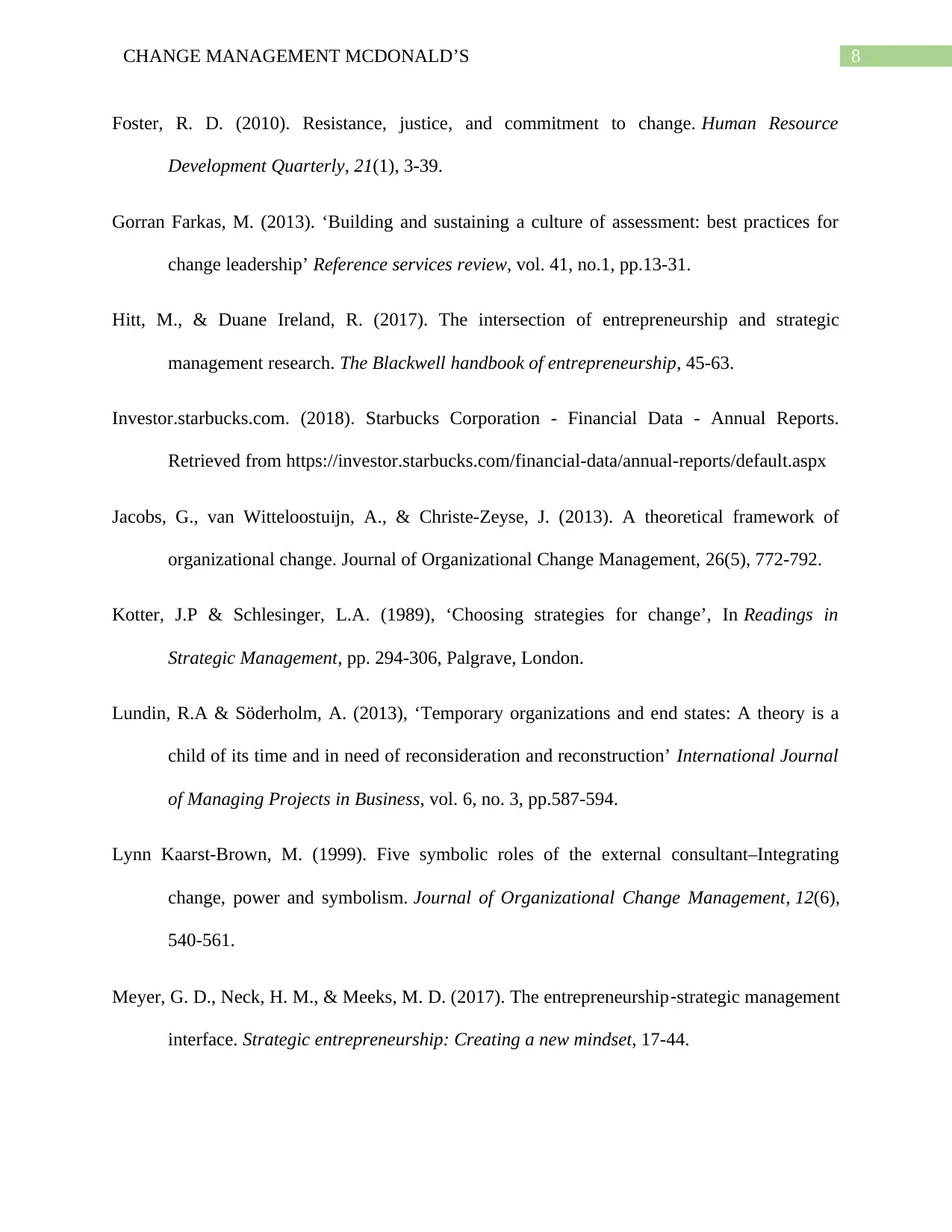
8CHANGE MANAGEMENT MCDONALD’S
Foster, R. D. (2010). Resistance, justice, and commitment to change. Human Resource
Development Quarterly, 21(1), 3-39.
Gorran Farkas, M. (2013). ‘Building and sustaining a culture of assessment: best practices for
change leadership’ Reference services review, vol. 41, no.1, pp.13-31.
Hitt, M., & Duane Ireland, R. (2017). The intersection of entrepreneurship and strategic
management research. The Blackwell handbook of entrepreneurship, 45-63.
Investor.starbucks.com. (2018). Starbucks Corporation - Financial Data - Annual Reports.
Retrieved from https://investor.starbucks.com/financial-data/annual-reports/default.aspx
Jacobs, G., van Witteloostuijn, A., & Christe-Zeyse, J. (2013). A theoretical framework of
organizational change. Journal of Organizational Change Management, 26(5), 772-792.
Kotter, J.P & Schlesinger, L.A. (1989), ‘Choosing strategies for change’, In Readings in
Strategic Management, pp. 294-306, Palgrave, London.
Lundin, R.A & Söderholm, A. (2013), ‘Temporary organizations and end states: A theory is a
child of its time and in need of reconsideration and reconstruction’ International Journal
of Managing Projects in Business, vol. 6, no. 3, pp.587-594.
Lynn Kaarst-Brown, M. (1999). Five symbolic roles of the external consultant–Integrating
change, power and symbolism. Journal of Organizational Change Management, 12(6),
540-561.
Meyer, G. D., Neck, H. M., & Meeks, M. D. (2017). The entrepreneurship‐strategic management
interface. Strategic entrepreneurship: Creating a new mindset, 17-44.
Foster, R. D. (2010). Resistance, justice, and commitment to change. Human Resource
Development Quarterly, 21(1), 3-39.
Gorran Farkas, M. (2013). ‘Building and sustaining a culture of assessment: best practices for
change leadership’ Reference services review, vol. 41, no.1, pp.13-31.
Hitt, M., & Duane Ireland, R. (2017). The intersection of entrepreneurship and strategic
management research. The Blackwell handbook of entrepreneurship, 45-63.
Investor.starbucks.com. (2018). Starbucks Corporation - Financial Data - Annual Reports.
Retrieved from https://investor.starbucks.com/financial-data/annual-reports/default.aspx
Jacobs, G., van Witteloostuijn, A., & Christe-Zeyse, J. (2013). A theoretical framework of
organizational change. Journal of Organizational Change Management, 26(5), 772-792.
Kotter, J.P & Schlesinger, L.A. (1989), ‘Choosing strategies for change’, In Readings in
Strategic Management, pp. 294-306, Palgrave, London.
Lundin, R.A & Söderholm, A. (2013), ‘Temporary organizations and end states: A theory is a
child of its time and in need of reconsideration and reconstruction’ International Journal
of Managing Projects in Business, vol. 6, no. 3, pp.587-594.
Lynn Kaarst-Brown, M. (1999). Five symbolic roles of the external consultant–Integrating
change, power and symbolism. Journal of Organizational Change Management, 12(6),
540-561.
Meyer, G. D., Neck, H. M., & Meeks, M. D. (2017). The entrepreneurship‐strategic management
interface. Strategic entrepreneurship: Creating a new mindset, 17-44.
⊘ This is a preview!⊘
Do you want full access?
Subscribe today to unlock all pages.

Trusted by 1+ million students worldwide
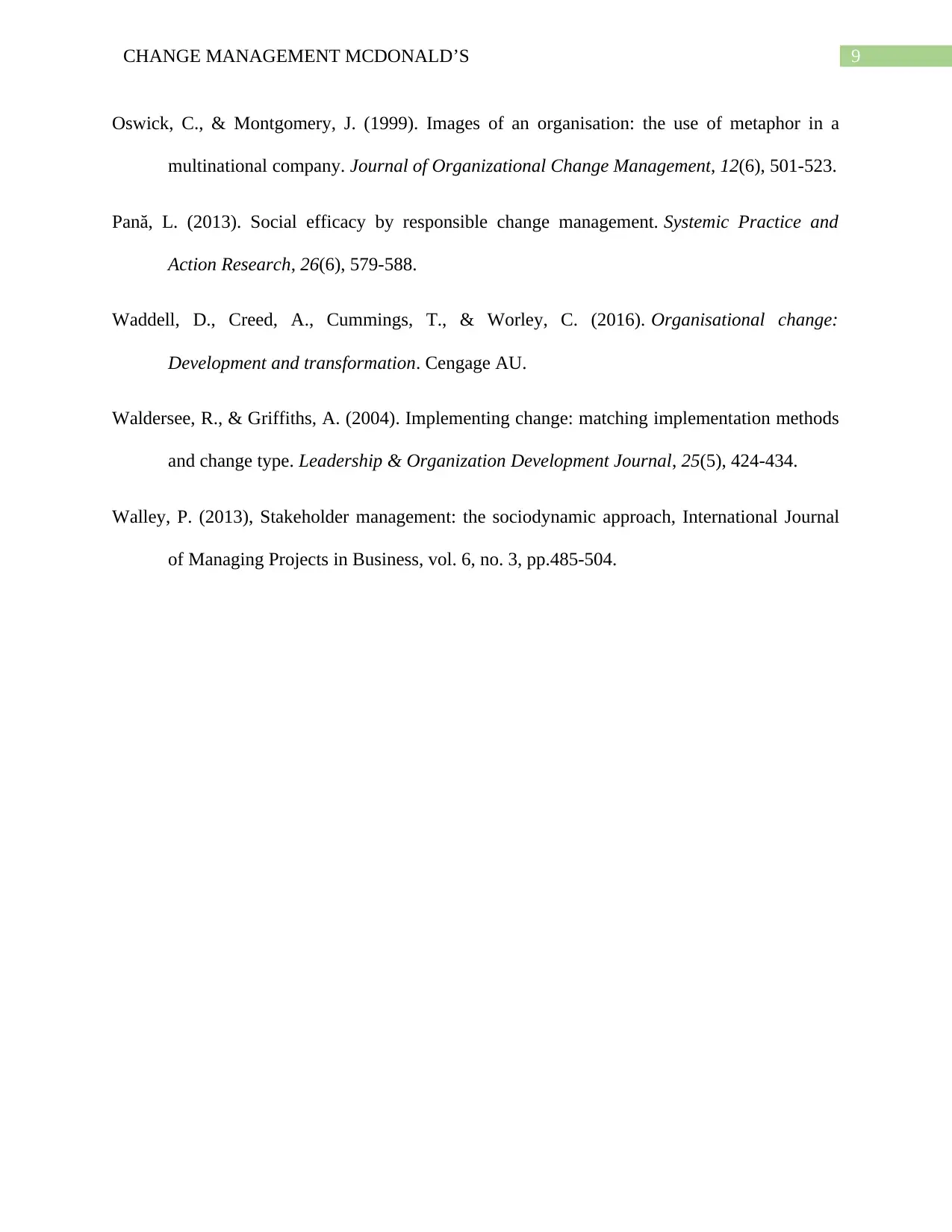
9CHANGE MANAGEMENT MCDONALD’S
Oswick, C., & Montgomery, J. (1999). Images of an organisation: the use of metaphor in a
multinational company. Journal of Organizational Change Management, 12(6), 501-523.
Pană, L. (2013). Social efficacy by responsible change management. Systemic Practice and
Action Research, 26(6), 579-588.
Waddell, D., Creed, A., Cummings, T., & Worley, C. (2016). Organisational change:
Development and transformation. Cengage AU.
Waldersee, R., & Griffiths, A. (2004). Implementing change: matching implementation methods
and change type. Leadership & Organization Development Journal, 25(5), 424-434.
Walley, P. (2013), Stakeholder management: the sociodynamic approach, International Journal
of Managing Projects in Business, vol. 6, no. 3, pp.485-504.
Oswick, C., & Montgomery, J. (1999). Images of an organisation: the use of metaphor in a
multinational company. Journal of Organizational Change Management, 12(6), 501-523.
Pană, L. (2013). Social efficacy by responsible change management. Systemic Practice and
Action Research, 26(6), 579-588.
Waddell, D., Creed, A., Cummings, T., & Worley, C. (2016). Organisational change:
Development and transformation. Cengage AU.
Waldersee, R., & Griffiths, A. (2004). Implementing change: matching implementation methods
and change type. Leadership & Organization Development Journal, 25(5), 424-434.
Walley, P. (2013), Stakeholder management: the sociodynamic approach, International Journal
of Managing Projects in Business, vol. 6, no. 3, pp.485-504.
1 out of 10
Related Documents
Your All-in-One AI-Powered Toolkit for Academic Success.
+13062052269
info@desklib.com
Available 24*7 on WhatsApp / Email
![[object Object]](/_next/static/media/star-bottom.7253800d.svg)
Unlock your academic potential
Copyright © 2020–2025 A2Z Services. All Rights Reserved. Developed and managed by ZUCOL.




